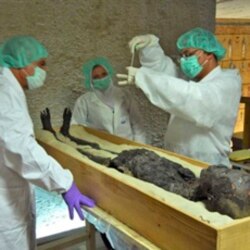Or download MP3 (Right-click or option-click and save link)
Read and listen to the article. Then open the activities on the right side of the page to improve your English!
Scientists say technology used to search people in airports could help doctors understand how some diseases developed.
Frank Ruhli is head of the Swiss Mummy Project at the University of Zurich. Five years ago, he used computed tomography to study the remains of Tutankamun, the famous boy ruler of ancient Egypt. A computed tomography, or CT, scan provides detailed images of the inner body. Doctor Ruhli used CT scans to investigate the cause of King Tut's death.
Now, he says, technology used to search airline passengers for explosives can provide even more information. Radiation used in CT scans may be harmful to the genetic material within mummified remains. However, no radiation is involved with terahertz imaging, also known as full body scan technology.
Doctor Ruhli says scientists could better understand mummies if they used both CT scans and terahertz imaging technology. For example, he believes it may be possible to examine substances within a mummy, like embalming liquid.
Recently, Doctor Ruhli and his team studied ways they could use terahertz imaging to examine mummies. He says the images they gathered appear very promising.
The mummification process protects the body’s soft tissue long after it would normally break down. The tissue may contain evidence of the virus or bacteria that caused the person to die.
Frank Ruhli is both a medical doctor and a paleo-pathologist. He says the information lying within mummies is not just interesting for historians, but other people. He says looking back thousands of years can help researchers look forward by understanding how a disease changed over time.
Researchers can produce a genetic map of a bacterium or virus. This way, they can observe changes in the structure of a deadly organism from one generation to the next.
Doctor Ruhli says researchers used this method to study changes in the tuberculosis bacteria from two thousand year-old mummified tissue. Scientists also completed similar research on victims of the Spanish flu epidemic in nineteen eighteen. Frank Ruhli says studies like this can prove useful in the fight against H1N1, another form of the influenza virus.
Doctor Ruhli presented his case for the value of mummies for medical research at a meeting of the American Association of Anatomists. He says this kind of research could never replace modern medical studies. But he says taking a long-term look at diseases can help provide information scientists might otherwise miss.




